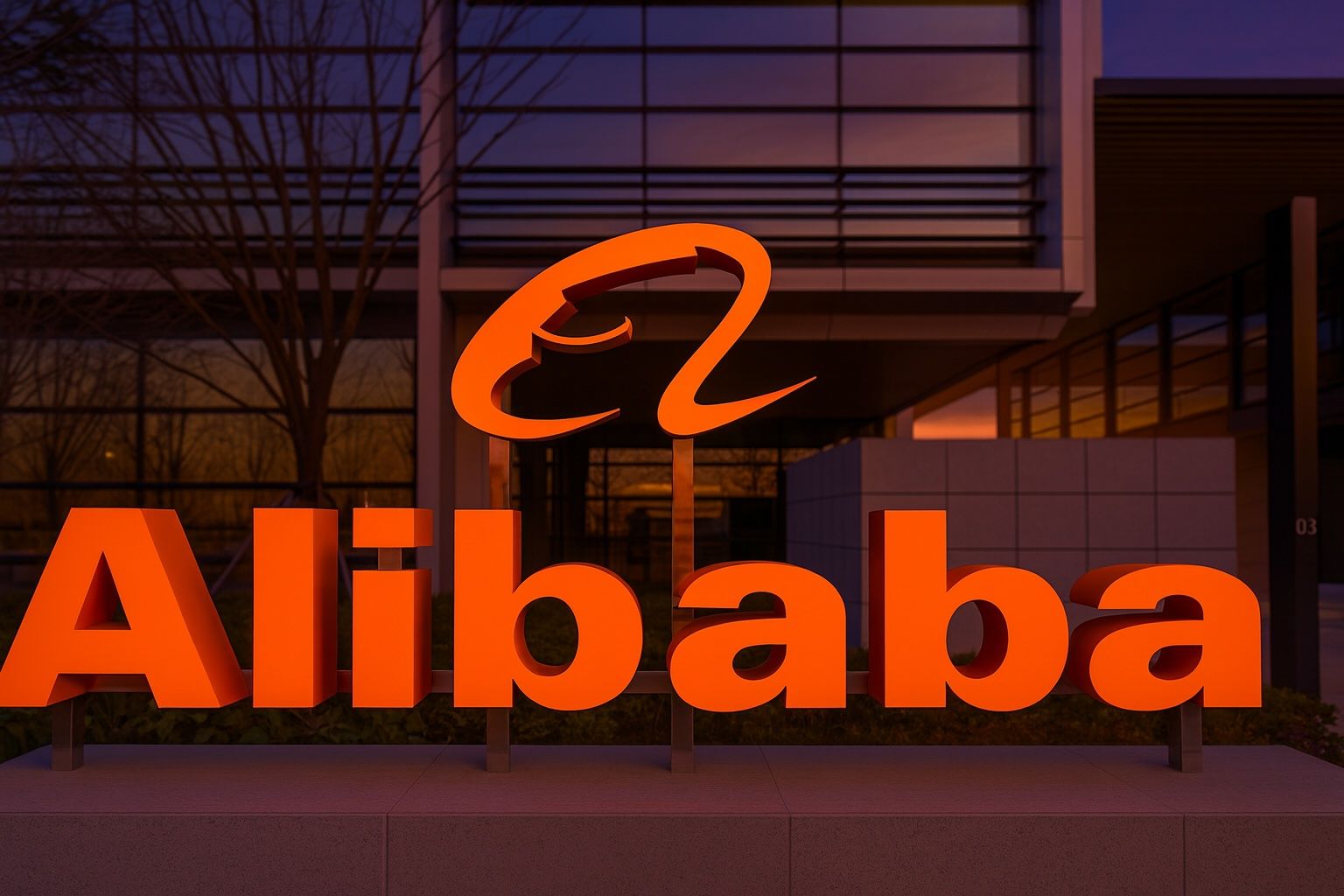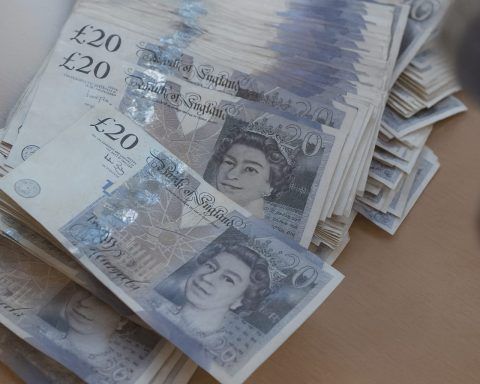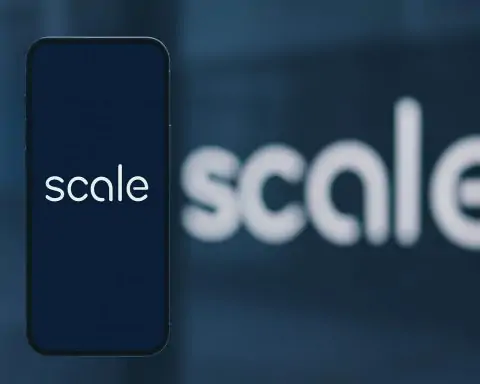- Alibaba stock rockets, then wobbles: 9988.HK closed at HK$165.40 on Oct 10 (–4.6% that day) [1], still up roughly 85% YTD. 2025 has seen massive rallies: Alibaba +100% and Tencent +60% [2] on a broader Chinese tech boom. Its surge was driven by bold AI/cloud bets – including unveiling the Qwen-3 Max 1-trillion parameter model and a ¥380B (~$53B) three‑year AI plan [3] [4] – and easing of the previous tech crackdowns.
- Market overheating in AI: By Oct 10 the “AI hype” reversed: Hong Kong AI names plunged (Alibaba –4.6%, Baidu –5.7%, SMIC –7.1%) [5]. Shanghai’s Cambricon – dubbed “China’s Nvidia” – fell 6.4% [6]. Analysts warn of frothy multiples: SMIC trades above a 300× P/E (above margin limits) and can’t sustain big drops if results disappoint [7]. Leverage is high: margin debt hit a record ¥2.4 trillion (≈$330B) on Oct 10 [8], reflecting FOMO buys of AI stocks.
- Hang Seng and Hong Kong slide: The Hang Seng Index fell 1.7% on Oct 10 to ~26,290 [9] [10] (a two-week low), as tech shares led losses. The tech-focused Hang Seng Tech index plummeted ~3.3% [11], dragging big names: Kuaishou –5.4%, Zhaojin Mining –7.4%, SMIC –7.2%, China Hongqiao –5.9%, Tencent –3.6% [12]. HK stocks’ pullback happened just after nine consecutive up sessions, reversing some of Sep’s gains.
- Trade war chill hits sentiment: Late on Oct 10 U.S. President Trump warned of a “massive” tariff hike – even 100% – on Chinese goods (from Nov 1) and tighter software export controls, in response to China’s rare-earth export curbs [13]. That shocked markets: U.S.-listed Chinese stocks fell (the ADR index plunged >6%), and Nvidia (entwined in export talks) dropped ~5% [14] [15]. “The tariff headline and new tech restrictions will spook sentiment right out of the gate,” warns Haris Khurshid of Karobaar Capital [16] – an outlook felt as markets braced for Monday’s open.
- Analysts upbeat but cautious: Wall Street is broadly bullish on Alibaba. About 15 of 16 analysts rate it a “Buy” [17], with price targets implying ~20–30% upside (JPMorgan HK$240, Jefferies $230 ADR, CLSA HK$200, etc. by 2026) [18]. Consensus 1‑year target is only slightly above current levels [19], suggesting much good news is priced in. Analysts cite Alibaba’s cloud/AI momentum (cloud sales +26% YoY last quarter [20]) and healthy balance sheet (net ~$23B cash) [21] as bullish factors, but warn margins will stay pressured by heavy tech investments [22] [23].
Alibaba’s AI-Powered Rally and Financial Strength
This year Alibaba (9988.HK) has broken out of its 2020–24 malaise. On Sept 24 the stock jumped as much as 7.8% intraday after it unveiled a major new AI model [24]. By Oct 3 it hit its highest in almost four years (~HK$186) [25]. Key drivers: co-founder Jack Ma has quietly reengaged, and new CEO Eddie Wu has doubled down on AI/cloud (vowing to spend ¥380B on AI over 3 years [26]). Alibaba’s cloud unit grew 26% in Q2 2025 [27], helping beat guidance even as core e‑commerce slowed. The company still generates fat profits: in the past 12 months it made $20.7B net on $139.7B revenue (~15% net margin) [28]. It finished FY2025 with ~$23B net cash and has been aggressively buying back shares ($11.9B repurchased, cutting float ~5%) [29] [30].
Its strong finances give Alibaba ammo even amid a renewed regulatory itch. While authorities recently summoned Alibaba over “harmful content” on its UC Browser [31], the broader tech crackdown has eased. China’s biggest antitrust fines (2021) are behind it, and Beijing now views big tech as a growth engine. Locally, investors on Alibaba’s long rally have raised targets but not gone overboard: the consensus 12‑month price target equals only about HK$165 per share (roughly current levels) [32]. Some experts note “a lot of good news” is already priced in [33]. Still, Wall Street bulls believe China’s AI boom and a possible cloud spin-off justify a premium – enabling further gains if earnings accelerate.
Chinese Market Boom & Bubble Signs
Chinese equities have soared in 2025. The Shanghai Composite and CSI 300 indices are up about 9%–12% over 1 year [34], outpacing the S&P 500. Hong Kong’s Hang Seng surged ~31% YTD [35] off the 2023 lows, as retail investors piled into tech and state-driven sectors. For context, Alibaba’s 100% gain and Tencent’s 60%+ rally are part of that surge [36]. Much of the rally came from a handful of “mega-themes” – AI chips, cloud, semis and automated tech. (For example, Cambricon Technologies jumped ~500% in a year [37] and robotics leader Inovance ~80%.)
Such narrow leadership raises concerns. On Oct 10, many of these big winners took a breather. Ts2.tech reports AI-related stocks in China “plunged” as the overheated hype triggered a sell-off [38]. In Hong Kong, China’s tech-heavy Star 50 index fell ~5.6% on Oct 10 [39], signaling profit-taking. Observers warned of a classic bubble pattern: sky-high P/E ratios and heavy margin. SMIC’s price-to-earnings (P/E) exceeded 300×, meaning it can’t be pledged for loans in China [40]. “Companies with high multiples… do not persevere if they do not perform,” says Ng Xin Yao, head of Asian investments at Everdeen Capital [41].
Breathing room may come from ample liquidity. Oct 10 saw ¥2.4 trillion in stock-margin debt – also a record [42] – meaning investors were highly leveraged into the rally. After the pullback, analysts note some cash is likely to rotate out of now-shaky tech names into more stable sectors. Kim Kyung-hwan of Hana Securities observes “liquidity has spread to undervalued stocks such as securities, coal, and food & beverage” as hot sectors cool [43]. Indeed, some strategists now expect a moderate correction or consolidation rather than a crash, given strong domestic buying power and policy support. Chinese households still have only ~5% of wealth in stocks, so major institutions (insurers, funds) and retail may keep buying on dips [44].
Trade-War Threats and Short-Term Risks
Just as investors were celebrating China’s AI gains, new U.S.-China tensions spooked markets. On Oct 10 President Trump signaled a “massive” tariff increase on Chinese imports (promising to double some duties and slap 100% tariffs on others starting Nov.1), plus broader export controls on tech products [45]. This reaction followed China’s own move to restrict rare-earth exports. The immediate effect was broad: U.S. markets wavered, the Nasdaq-100 slid (Nvidia fell ~5%), and Chinese ADRs plunged on Friday [46]. On Sunday, China warned it “would not hesitate” to retaliate further if tariffs bite.
Markets expect these headlines to knock Hong Kong and Shanghai lower on Monday. Haris Khurshid warns that “China’s markets will likely open under pressure on Monday… the tariff headline and new tech restrictions will spook sentiment right out of the gate” [47]. That’s after a holiday-shortened week saw blockbuster U.S. jobs data dampen bond yields, so investors had already positioned for Fed easing. Now there’s fear of renewed geopolitical headwinds. Chinese authorities face a balancing act: dampening panic without blowing up the stock party. Given today’s rally backdrop, policy must avoid shooting the economy in the foot.
For example, Guotai Junan’s chief economist Hao Zhou notes that this uncertainty might be “transient” – a tariff “scare” rather than a full-blown collapse [48]. Many expect Beijing to ring-fence its market. On Friday evening Chinese state media and officials largely downplayed the headlines. The People’s Bank of China (PBoC) has already signaled support (cutting banks’ reserve requirements recently). If major data (trade, CPI) due next week disappoints, Beijing might step in with easing or stimulus to stabilize sentiment.
Hang Seng & Hong Kong Outlook
Hong Kong’s markets mirror these cross-currents. On Oct 10 the Hang Seng fell 1.7% to 26,290 [49], the fifth straight day of losses. But that ignores how far it’s come in 2025. The Hang Seng China Enterprises (H‑share) Index and broader Hong Kong markets have spent much of the year near decade-highs. Even with Friday’s drop, the Hong Kong stock benchmark remains up about 30% in 2025 [50]. Crucially, investor focus in Hong Kong is splitting. Mainland tech giants (Tencent, Meituan) and AI plays led the run-up, but now sectors like banks, brokers and commodity exporters are catching buying.
Analysts caution that Hong Kong stocks face higher volatility. The Hang Seng Tech index’s 3.3% fall on Friday [51] suggests the tech-led gains may pause or give back some ground. But there are tailwinds: many U.S. investors still eyeed Hong Kong as their China exposure. And as long as the Fed moves to cut rates (widely expected by late Oct), global liquidity could buoy markets. One note on the Fed: any U.S. weakness could spill into Hong Kong via stock flows, but also help narrow the U.S.-China yield gap that’s drawn capital out of emerging Asia.
Forecasts & Key Takeaways
In sum, China’s tech-stock rollercoaster may have more ups than downs in 2025. The structural forces – booming AI adoption, strong corporate balance sheets, and eventual policy support – argue for a continued bull market in the medium term. Many fund managers still see China equities as undervalued relative to their growth, especially if they can ride out short-term shocks. 15 of 16 analysts tracking Alibaba rate it a “Buy” [52], and for long-term believers the company’s next earnings and Singles’ Day sales (Nov 11) are key catalysts.
But traders must be nimble. In the near term, risks abound. If trade tensions spiral, expect quick sell-offs: a repeat of early October moves could take 10–15% off the largest tech names. On the flip side, any sign of détente (e.g. cancelled tariffs or resumed talks) could trigger another leg up. Experts like Angelo Zino of CFRA note Alibaba’s current strategy prioritizes growth over profit, compressing margins [53] – a reminder that hype can run ahead of actual earnings. Smarter investors will watch valuations closely: a peg around 15× forward earnings (current Alibaba ADR) is fair, but even a slight miss in China’s economic data could test that assumption.
Key forecast: We expect volatility to remain high into October. A modest pullback or consolidation in Chinese tech stocks is likely as short-term sentiment cools. But the consensus view is cautiously optimistic: China’s domestic liquidity, combined with Beijing’s willingness to support markets, suggests any downturn will be limited. In the words of Everdeen’s Ng: stocks with sky-high multiples “do not persevere if they do not perform,” underscoring the need to balance greed with caution [54]. As one strategist quipped, today’s pullback may just be a “profit-taking party” rather than a panic. Investors should stay diversified and keep an eye on the data (trade flows, exports, industrial output) and policy signals.
Bottom line: Chinese tech stocks have delivered outsized returns in 2025, led by Alibaba’s AI pivot and a once-in-a-decade surge. But with the door open to trade-war skirmishes and potential market overheating, the story is now in the profit-taking and rotation phase. Future gains will depend on fundamentals (earnings, consumer demand) catching up with expectations, and on how policymakers navigate the new tensions. Watch for this duel of bull-run momentum versus risk-off headlines – and remember the age-old market wisdom: “Don’t fight the Fed,” but also “don’t ignore a tariff.”
Sources: Reports from Bloomberg and South China Morning Post on Oct 12 warn of a revived trade-war hit to Chinese stocks [55] [56]. TradingView/Xinhua data confirm the Oct 10 Hang Seng plunge [57] [58]. Maeil Business News (Korea) and TS2.Tech provide detail on Chinese AI stock swings and liquidity in early Oct [59] [60]. Tech industry analysis (TS2.Tech) details Alibaba’s tech conference and analyst outlook [61] [62]. Expert comments (Khurshid, Ng, Kim, Goz) contextualize the split between U.S.-led R&D and China’s AI deployment [63] [64] [65] [66].
References
1. www.investing.com, 2. www.scmp.com, 3. ts2.tech, 4. ts2.tech, 5. ts2.tech, 6. ts2.tech, 7. www.mk.co.kr, 8. www.mk.co.kr, 9. www.tradingview.com, 10. english.news.cn, 11. english.news.cn, 12. www.tradingview.com, 13. www.bloomberg.com, 14. www.scmp.com, 15. www.scmp.com, 16. www.scmp.com, 17. ts2.tech, 18. ts2.tech, 19. ts2.tech, 20. ts2.tech, 21. ts2.tech, 22. ts2.tech, 23. ts2.tech, 24. ts2.tech, 25. ts2.tech, 26. ts2.tech, 27. ts2.tech, 28. ts2.tech, 29. ts2.tech, 30. ts2.tech, 31. ts2.tech, 32. ts2.tech, 33. ts2.tech, 34. www.reuters.com, 35. www.scmp.com, 36. www.scmp.com, 37. www.reuters.com, 38. ts2.tech, 39. ts2.tech, 40. www.mk.co.kr, 41. www.mk.co.kr, 42. www.mk.co.kr, 43. www.mk.co.kr, 44. www.reuters.com, 45. www.bloomberg.com, 46. www.scmp.com, 47. www.scmp.com, 48. www.scmp.com, 49. english.news.cn, 50. www.scmp.com, 51. english.news.cn, 52. ts2.tech, 53. ts2.tech, 54. www.mk.co.kr, 55. www.bloomberg.com, 56. www.scmp.com, 57. www.tradingview.com, 58. english.news.cn, 59. ts2.tech, 60. www.mk.co.kr, 61. ts2.tech, 62. ts2.tech, 63. www.scmp.com, 64. www.mk.co.kr, 65. www.mk.co.kr, 66. www.mk.co.kr









